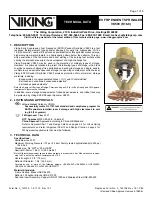
Chapter 12: Maintenance
_________________________________________________________________________________________
43 | Installation, Operation & Maintenance Instructions EASYCHLORGEN
12. Maintenance
Products by Lutz-Jesco are manufactured to the highest quality
standards and have a long service life. However, some parts are
subject to operational wear. This means that regular visual
inspections are necessary to ensure a long service life. Regular
maintenance will protect the system from operational
interruptions.
DANGER!
Mortal danger from electric shock!
Live parts can inflict fatal injuries.
Disconnect from the electricity supply before working on any
equipment.
Secure all devices to prevent it from being switched on
again.
WARNING
Increased risk of accidents due to insufficient
qualification of personnel!
The system and its accessories may only be installed, operated
and maintained by personnel with sufficient qualifications.
Insufficient qualification will increase the risk of accidents.
Ensure that all action is taken only by personnel with
sufficient and corresponding qualifications.
12.1 Maintenance Intervals
The system requires regular maintenance to prevent errors,
poor performance and even failure. This table gives an overview
of maintenance work and the intervals at which you must carry it
out. The next few sections contain instructions for carrying out
this work.
Interval
Level
Maintenance
As required
Trained
persons
Clean or replace in-line brine
strainer screen
Clean/replace in-line PRV
strainer screen
Annual
Specialist
staff
In addition to above:-
Check/Test hydrogen gas
sensor function
PSU housekeeping
2 yrs (or >10,000
operating hours)
Specialist
staff
In addition to above:-
Replace product pipe
seals/gaskets
12.1.1 Clean/replace brine strainer screen
Depending on quality of the softened cold water supply and salt
specification, the in-line strainer screen protecting the brine
control solenoid valve may periodically require cleaning or
replacing.
One of the reasons the EASYCHLORGEN may
alarm “VOLTAGE HIGH” is due to a restriction in
brine flow, resulting in a low salinity brine solution
entering the electrolytic cell. The system is designed
to shut down in the event of high voltage conditions.
Precondition for action:-
Place the system in to short term shutdown. See section
11.1
Biennial service kit available, see section 14 “Spare Parts”
•
Refer to the diagram in 12.4.3 for component location detail
Perform the following working steps:-
1.
Ensure the ball valve is closed immediately upstream of the
brine strainer assembly.
2.
Unscrew the strainer screen plastic securing bonnet to
remove the entire screen assembly.
3.
By unclipping the end of the strainer cage, the screen can
be removed for cleaning in warm soapy water or replaced
with a new replacement screen.
4.
After cleaning/replacement of the screen, apply a small
amount of silicone grease to the bonnet thread and O-ring
before refitting the screen assembly hand tight only.
5.
Re-open the ball valve and start-up the system as per
section 9.2.
The brine strainer has been successfully
cleaned/replaced.
12.1.2 Clean/replace water PRV strainer screen
Precondition for action:-
Place the system in to short term shutdown. See section
11.1
Biennial service kit available, see section 14 “Spare Parts”
•
Refer to the system diagram in 12.4.3 for component
location detail and component diagram below,
Perform the following working steps:-
1.
Ensure the ball valve immediately upstream of the cold
water feed Pressure Regulation Valve (PRV) is closed.
2.
Unscrew the strainer screen brass securing bonnet “1”
located at the base of the PRV to remove the entire screen
assembly.
















































